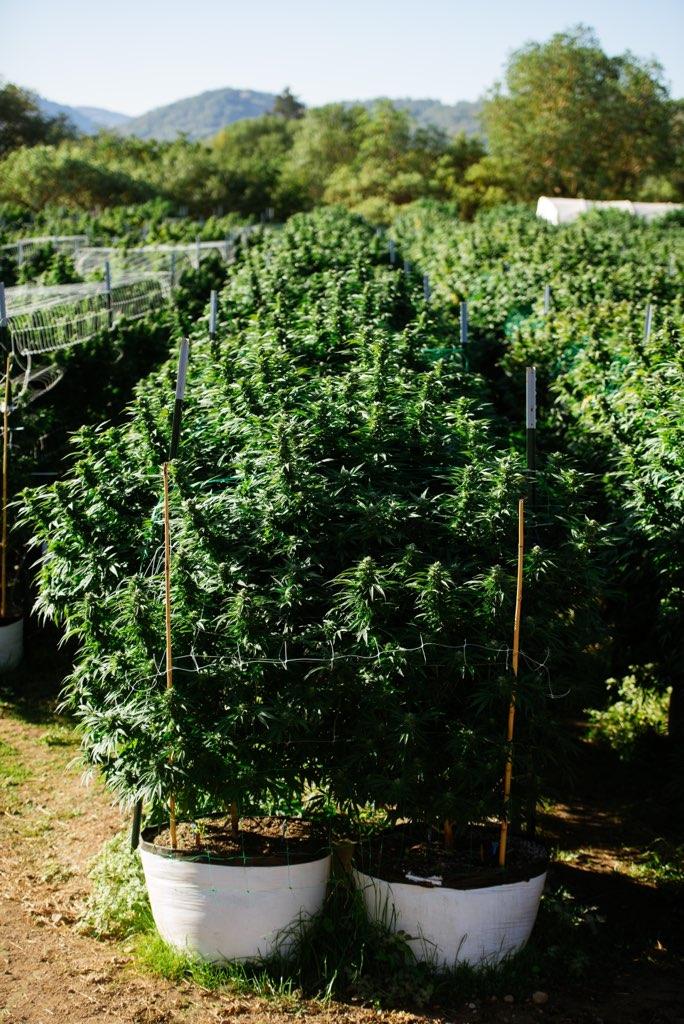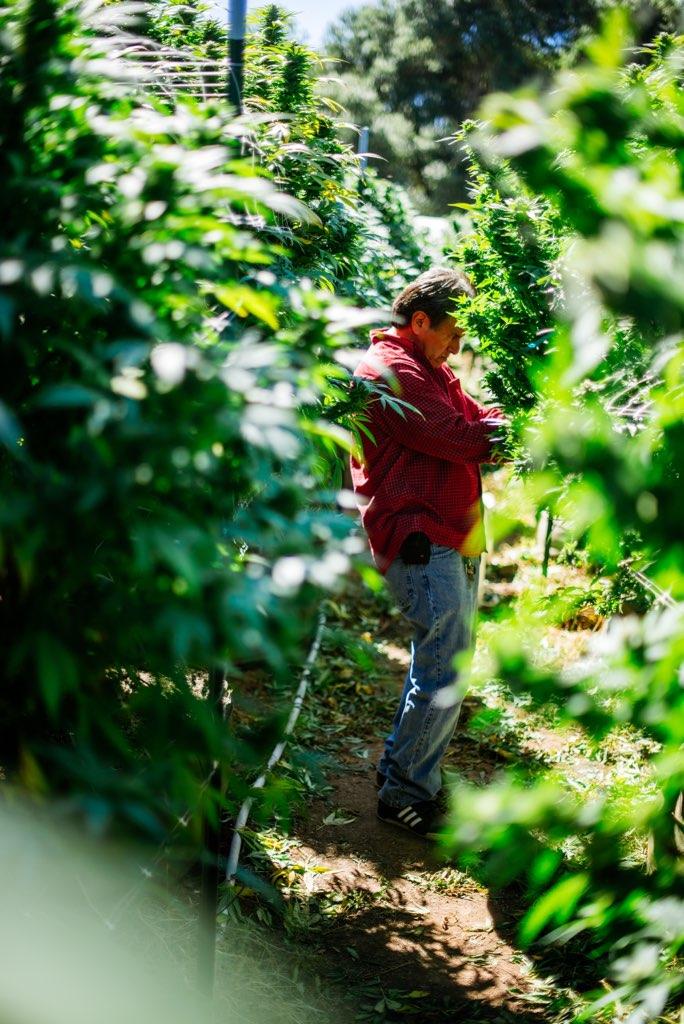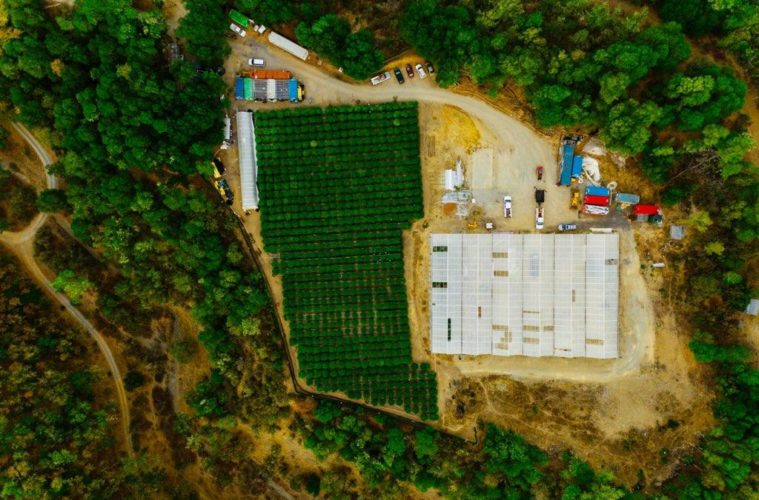Things are kicking into high gear on cannabis farms around the state as California prepares for its massive annual outdoor harvest.
After months of effort, the annual wave of outdoor is almost ready for consumers in California and beyond. While we’ll focus on the regulated industry for this piece, make no mistake about it, the harvest season provides an annual flood of good weed across the country. And in many cases, the further you get from the Emerald Triangle, the less likely people will even realize it’s outdoor.
For Harvest 2021, there is seemingly more pot to go around in September than ever before. As permitted operators get ready to chop down their plants, they’re getting their ducks in a row to bring the most competitive product to market possible.
One of the legacy operations preparing for things to get very busy in the next few weeks is WildLand Cannabis. WildLand’s co-owner Joey Gothelf and his farm partner Jenn moved out from Philly to take part in the medical cannabis industry a decade ago. Following Prop. 64, they went all-in on legal cannabis.
“I mean listen, it’s tough because it’s definitely not what it was, on every level conceivable,” Gothelf told L.A. Weekly. “So it’s been tough. We made the decision to do the regulated thing when it happened – to go all in. We didn’t want to stop what we were doing.”
But they also didn’t want to be in the shadows doing this forever. Gothelf noted he’s had data entry jobs in the past, so taking care of the inventory in the METRC tracking system many states use to track cannabis products was a breeze.
As for the harvest, Gothelf is in the final construction stage of upgrading the barn they use for drying.
Gothelf went on to compare the vibes on the hill for Harvest 2021 with his earliest experiences up north a decade ago. He said this particular moment is weird because of how prices have dropped.
“Prices are in the toilet – in the basement – right now and it’s unfortunate because harvest time is not cheap if you’re hiring people, or expenses start rolling in again,” Gothelf said, noting costs go down a bit while the plants are in the ground finishing up. “And then harvest time hits, and your expenses go back through the roof, especially if you’re employing people. So it’s been tough knowing the financial landscape that’s going on in the regulated cannabis market now that prices are so low.”
Gothelf said he believes the most important message cannabis consumers can get this harvest season is it might be one of the last ones where you can support legacy farmers. He believes corporate cannabis is angling to consolidate the industry even further over the next few years. He emphasized that once these farmers are gone, they aren’t coming back. Now is the time to support them or there will be a bunch of midsy generic cannabis on the legal market forever.
“It’s going to create a market where there’s very little interesting weed, in my opinion at least,” he said. “So I think it’s important this harvest season to keep the small farmers in mind, especially those of us that have been affected by wildfires and are really trying to make up for last year being really tough because of the fires.”
Over at Moon Gazer Farms, also in Mendocino, owner Josh Khankhanian preps for their annual single harvest.
“We’re getting all of our drying racks ready to go and just keeping everything nice and washed up and clean. And getting all of our tools in order, all of our printers and everything,” Khankhanian told L.A. Weekly. “We have a lot of our infrastructure in place already. We’re doing some freezers this year too.”
In recent years, the fresh frozen product from the harvest has become a commodity for hash producers, while at the same time simplifying part of the harvest for farmers. Anything going in the freezer is going to get a lot less manicuring, saving farmers time and money.
“Ever since legalization we’ve kind of just been doing a little bit every year. It’s been just time and money to invest in infrastructure,” Khankhanian said. “We just haven’t been able to do it all in one year. So two years ago we built the barn, just in time to do a little harvesting and then last year we did a lot of harvesting in the barn and this year it’s all insulated now.”
With the new insulation, Khankhanian hopes to be able to hold his barn at right around 60 degrees with 50% humidity. He feels this temperature and humidity pairing maximizes the results of the drying process. The gold standard being hearing an audible snap from the stem, while the nugs are too sticky to break up with your fingers.
Moon Gazer will start early harvest this week. But they really expect to put their foot on the gas in about three weeks.
“We don’t really know what to expect. We’re just going to make sure that most of it gets sold by like March,” Khankhanian said. “I don’t expect the prices to be that great, but I think they’ll be good enough that we can keep going for another year and just kind of see where things are at, a year from now.”
We asked Khankhanian how much of the mentality for legacy operators was just to hold on until they can sell their product legally outside of California?
“Yeah, exactly, or overseas and all that kind of stuff,” he replied. “I mean, that’s gonna definitely open things up for us and bring the price back up too. But you know we still work with a couple of really great dispensaries and stuff, who can still get us a good price.”
The Emerald Sun team in Ukiah is preparing to distribute cannabis from numerous farms across the Emerald Triangle. While some distribution companies up north have full public relations arms, Emerald Sun tends to avoid media as to not take away from the farmers they work with. But with a little light pressing, CEO and Co-founder Brett Schlesinger was willing to share a bit about how the company is getting ready.
“Look, our take on it is that in this market, it’s really all about quality, given how much flower is going to be in the market,” Schlesinger told L.A. Weekly.
The battle to produce top-quality cannabis will also transcend scale this harvest. Schlesinger argued that since the quality will be king in the saturated market, if the little mom and pop producers can produce the heat, it will still move. Especially given how much bad pot is about to drop too.
“The challenge for the smaller producers is that there’s just way less cushion,” Schlesinger said. “Let’s say that they have a season where they produce 75% super top quality, and the rest, average or lower. That might have worked in years past, but not if they’re not getting the numbers for that top quality. Again, there’s just less overall cushion for those types of size businesses to have a sustainable operation.”
Schlesinger thinks it is definitely starting to feel more like a commodity market, and it’s certainly a buyer’s market due to the amount of material. We asked if it felt like farmers are pulling the trigger on deals faster now than in the past?
“Every farmer has to make the decision that’s best for them,” Schlesinger replied. “But it’s not like in seasons past where we’re seeing the same holding out and then getting higher prices.”
There is just so much flower now.
Schlesinger explained the core of what Emerald Sun does as a business is essentially serve as a supply chain partner for farmers. In that sense they the company finds itself involved in more hands-on processes than many distribution entities. The ultimate goal is to set up things ahead of time that will allow the farming partners to produce the most competitive cannabis possible.
For Mario “Mr. Sherbinski” Guzman, the last five years have seen the harvests backing his Sherbinskis brand continue to keep growing with it. And even as he sees more and more shelf space for his product and takes a more active role in the wider industry, including recently joining the Minority Cannabis Business Association board, the outdoor harvest has been a key component to an industry legend who got famous cultivating in the basements and garages of San Francisco.

Gelato reaching it’s full potential under the sun.
Guzman first pointed to the wider supply chain issues that are ongoing through the pandemic, and it’s not just weed stuff. Some experts are recommending starting your Christmas shopping now. But Guzman was more concerned with the stores running out of scissors rather than PS5s.
“All the supplies and things that always run out, like gloves and scissors and all the basic consumables of harvest,” Guzman told L.A. Weekly. “We ordered all that stuff way ahead of time to make sure that we had all those things in place. One of the things that I really focused on this year was just prepping, everything, months in advance.”
Guzman’s harvest will be a lot more dynamic than in years past. The site in southern Mendocino has been built out for a while, but this year the weed will be going in more directions. A lot more will be going into the freezer as his vape lines continue to grow in popularity. He’ll also be outsourcing the trimming offsite. The fewer hands on deck the better during the harvest season. More hands than needed just creates more security holes. Much of the team around him now have been on the crew for years.

The Sherbinskis team caring for the monster plants.
“And you know it’s problematic when you’ve got 30 people up there the whole harvest season,” Guzman said. “It’s just that you don’t know everybody and we’re taking good measures to make sure that everything is secure and safe and also to keep our employees safe. So just taking a lot of measures to go over everything.”
Guzman has never had an issue with the annual flood. The original Gelato genetics from the mothership move regardless of how much weed other people have. But he does think it gives further credit to his decision as an already famous breeder to come out and brand heavy years ago when he decided to be more public in general.
“It points to the importance of the brand and why I started the brand. I knew that when it came down to it, there’s got to be a way for you to separate yourself from everybody else because in California there’s so many growing a quality flower. You know I wouldn’t claim to be the best grower, by far.”
To Guzman’s defense, he certainly seems to know what he is doing these days. He thinks the thing that made the brand enduring to the consumer was always holding on to that original Gelato magic that changed everything in the first place.
“It’s just like other stuff. Just say you want a chocolate bar. People might reach for Hershey before they reach for, you know, say, the 10 other brands that have great packaging and look awesome, but people know that Hershey has been around forever and they know what it tastes like and they trust it,” Guzman said.
Guzman noted that even with everything going on in the world and on the hill, this is one of the most important times of year to be a good neighbor.
“With the fires and with a lack of water and everything, we’re challenged with right now. Check on your neighbors. Look out for each other and just be safe. And happy harvest everybody, and congratulations on everyone’s hard work all season and you know we’re close to enjoying the fruits of our labor,” Guzman said.
Advertising disclosure: We may receive compensation for some of the links in our stories. Thank you for supporting LA Weekly and our advertisers.

